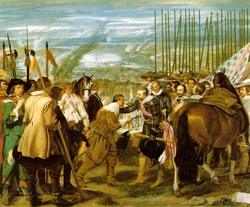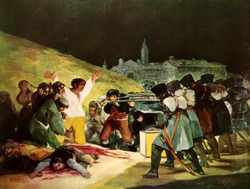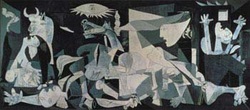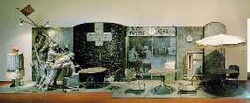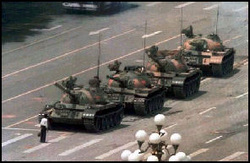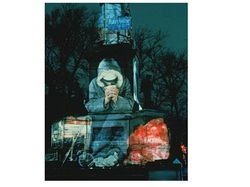Let's Get Started!
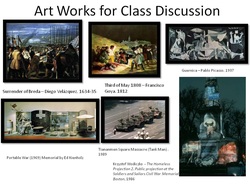
What are these artworks about?
Lesson 1: From Documentary to Commentary: Art Has More Than One Purpose
Lesson Description: This lesson will provide students an opportunity to understand how an artwork can appear to be just documentary yet, at the same time, be making a comment about an event or issue. Through small and large group discussion structures, students will discover how selected artworks may have more than one purpose. Students will compare and contrast art works to construct understanding of the artist's purpose for the work.
Lesson Description: This lesson will provide students an opportunity to understand how an artwork can appear to be just documentary yet, at the same time, be making a comment about an event or issue. Through small and large group discussion structures, students will discover how selected artworks may have more than one purpose. Students will compare and contrast art works to construct understanding of the artist's purpose for the work.
Lesson Length: 1 (90) minute class
Art Level: Advanced Art (11th, 12th grades)
Essential Understandings:
Lesson Specific Objectives: The student will...
Materials:
Procedures:
1. The teacher will ask the students what do Pablo Picasso and Alan Jackson have in common? Then proceed to show them a short music video of Jackson's song Do You Remember, which features images from the attack on 911 then transitions to the attack on Guernica in 1937.
** (Answer: They both used their art to comment on a tragic event.)
** The teacher will present 6 artworks from different time periods with a common theme of war or conflict for class discussion. The teacher will document student responses on the board.
Discussion Guiding Questions:
3. Students will also receive a packet of information about the artist, artwork, historical and sociological information surrounding the artwork.
4. Student groups will read and discuss the information and how it relates to their interpretation of the artwork.
5. Each group will work as a team to write a new critique of the artwork based on their understanding of the artwork in context to the new background information.
6. Each group will create 3 questions they think everyone should be able to answer about the artwork. (These questions will be used as part of the summative assessment)
7. Each group will present their artwork to the class and explain the following:
** Students must be able to answer the questions they created through their presentation.
Assessments
Formative Assessments:
Grading Rubrics
Written Critique:
Letter Grade of A: Critique described the artwork in detail noting the main subject and use of color. The composition was analyzed noting the main compositional elements and how they relate to each other. The critique referenced the time period it was made in and how the artist referenced or documented that time. The artwork was interpreted for meaning and that interpretation was supported by visual facts form the artwork and related history of the time period. Critique explained what makes the artwork a simple documentation or a more complex commentary and supported their statements with facts form the artwork or from the research about the artist or time period.
Letter Grade of B: Critique described the artwork noting the main subject. The composition was analyzed noting the main compositional element. The critique referenced the time period it was made in and how the artist referenced or documented that time. The artwork was interpreted for meaning and that interpretation was supported by visual facts form the artwork and related history of the time period. Critique explained what makes the artwork a simple documentation or a more complex commentary.
Letter Grade of C: Critique gave a basic description of what is seen in the artwork. The composition was analyzed noting the main subject and how the artist created emphasis. Reference was made to the available research in determining the artwork’s meaning or message. Critique explained what made the work a documentary or commentary art piece.
** No D or F ** Critiques that do not meet at least the “C” mark will have to be rewritten.
Group Presentation
Letter Grade of A: Group did not read directly from their critique but did explain the how the artwork was composed, what the significant elements in the work are, what was happening in the time the art was created, what (if any) symbolism was included in the work, and what and how the artwork documents or makes a comment about. Group answered the questions they proposed about their artwork for use in the end test.
Letter Grade of B: Group read directly from their critique. Group made some connections between imagery in the artwork and the time period it was created in. Group described what made the work a successful documentary or commentary artwork. Group answered the questions they proposed about their artwork for use in the end test.
Letter Grade of C: Group pointed out some of the significant features of the artwork. Group made some connections between imagery in the artwork and the time period it was created in. Group described what made the work a successful documentary or commentary artwork. Group addressed some of questions they proposed about their artwork for use in the end test.
Art Level: Advanced Art (11th, 12th grades)
Essential Understandings:
- Throughout history, art has been created to document and reflect the society in which it was created.
- Art can raise awareness to social and political issues.
- Artists have a role in documenting and shaping society.
- Can an artwork be both documentaries to commentary?
- What has made it possible for artists to move from creating documentary artworks to creating commentary artworks about conflict and social issues?
- What makes an artwork a commentary rather than just a documentary of an event or social issue?
- What techniques to artists employ to communicate the intent of their artwork?
Lesson Specific Objectives: The student will...
- Understand how art about war and conflict has changed from being documentary to becoming commentary.
- Understand why artists choose to create a documentary or commentary artwork.
- Understand what social and technological changes have influenced the change in the purpose of art from documentary to commentary.
- Find similarities between music in the visual arts when it comes to documenting and commenting on history and social issues.
- Write and present a critique of a chosen artwork in relation to its historical and commentary messages.
Materials:
- Print and Digital Images of artwork
- Teacher compiled Artist /Artwork printed resource packets
- LCD Projector, Computer
- Large poster boards and Markers
- Teacher made music video comparing Alan Jackson and Pablo Picasso
Procedures:
1. The teacher will ask the students what do Pablo Picasso and Alan Jackson have in common? Then proceed to show them a short music video of Jackson's song Do You Remember, which features images from the attack on 911 then transitions to the attack on Guernica in 1937.
** (Answer: They both used their art to comment on a tragic event.)
** The teacher will present 6 artworks from different time periods with a common theme of war or conflict for class discussion. The teacher will document student responses on the board.
Discussion Guiding Questions:
- What is happening in these artworks?
- What do these artworks have in common?
- How are these artworks alike and different?
- What are the purposed for these artworks? (Documentary, Commentary or Both)
- Which artworks are documenting an event? Which are commenting about an event?
- How can you tell the difference?
- Does the media used effect the impact of the artworks?
- What if a different media were used with the same composition would it be more or less effective?
3. Students will also receive a packet of information about the artist, artwork, historical and sociological information surrounding the artwork.
4. Student groups will read and discuss the information and how it relates to their interpretation of the artwork.
5. Each group will work as a team to write a new critique of the artwork based on their understanding of the artwork in context to the new background information.
6. Each group will create 3 questions they think everyone should be able to answer about the artwork. (These questions will be used as part of the summative assessment)
7. Each group will present their artwork to the class and explain the following:
- Artist, Title, Media, Date, Description and Compositional Analysis
- Intended purpose of the artwork. (Documentary, Commentary, Both)
- Social climate surrounding the artwork at its creation (what was happening in the world at the time)
- The message of the artwork
** Students must be able to answer the questions they created through their presentation.
Assessments
Formative Assessments:
- Monitor student participation in large and small group discussion and investigation.
- Questions submitted and answered.
- Written Critique of the artwork
- Group presentation of the artwork
Grading Rubrics
Written Critique:
Letter Grade of A: Critique described the artwork in detail noting the main subject and use of color. The composition was analyzed noting the main compositional elements and how they relate to each other. The critique referenced the time period it was made in and how the artist referenced or documented that time. The artwork was interpreted for meaning and that interpretation was supported by visual facts form the artwork and related history of the time period. Critique explained what makes the artwork a simple documentation or a more complex commentary and supported their statements with facts form the artwork or from the research about the artist or time period.
Letter Grade of B: Critique described the artwork noting the main subject. The composition was analyzed noting the main compositional element. The critique referenced the time period it was made in and how the artist referenced or documented that time. The artwork was interpreted for meaning and that interpretation was supported by visual facts form the artwork and related history of the time period. Critique explained what makes the artwork a simple documentation or a more complex commentary.
Letter Grade of C: Critique gave a basic description of what is seen in the artwork. The composition was analyzed noting the main subject and how the artist created emphasis. Reference was made to the available research in determining the artwork’s meaning or message. Critique explained what made the work a documentary or commentary art piece.
** No D or F ** Critiques that do not meet at least the “C” mark will have to be rewritten.
Group Presentation
Letter Grade of A: Group did not read directly from their critique but did explain the how the artwork was composed, what the significant elements in the work are, what was happening in the time the art was created, what (if any) symbolism was included in the work, and what and how the artwork documents or makes a comment about. Group answered the questions they proposed about their artwork for use in the end test.
Letter Grade of B: Group read directly from their critique. Group made some connections between imagery in the artwork and the time period it was created in. Group described what made the work a successful documentary or commentary artwork. Group answered the questions they proposed about their artwork for use in the end test.
Letter Grade of C: Group pointed out some of the significant features of the artwork. Group made some connections between imagery in the artwork and the time period it was created in. Group described what made the work a successful documentary or commentary artwork. Group addressed some of questions they proposed about their artwork for use in the end test.
Images for class discussions about how artists have documented and commented on conflict at the same time.
Each of the artworks below are links to their original sites. You can find useful information about the artworks on their home sites.
Applicable Virginia Standards of Learning.
- AIV.13 - The student will use an extensive, high-level art vocabulary to analyze, evaluate, and interpret works of selected artists.
- AIV.14 - The student will describe where, when, and by whom specific works of art were created.
- AIV.16 - The student will identify the influences of selected artists on society and culture.
- AIV.20 - The student will use an extensive, high-level art vocabulary related to design, composition, aesthetic concepts, and art criticism when discussing works of art.
- AIV.24 - The student will demonstrate the ability to conduct an effective critique.
- AIV.25 - The student will critically view the quality and expressive form of works of art as a source of inspiration and insight and as a potential contribution to personal works of art.
- AIV.30 - The student will justify personal perceptions of an artist’s intent, using visual clues and research.
